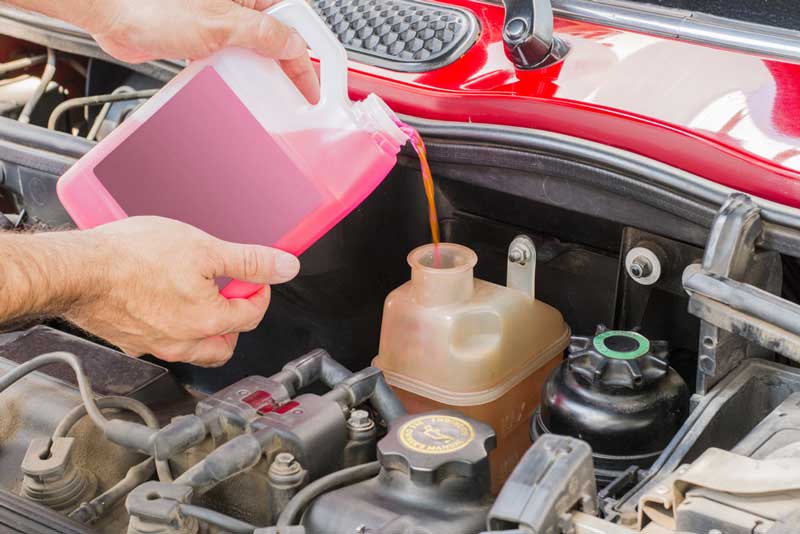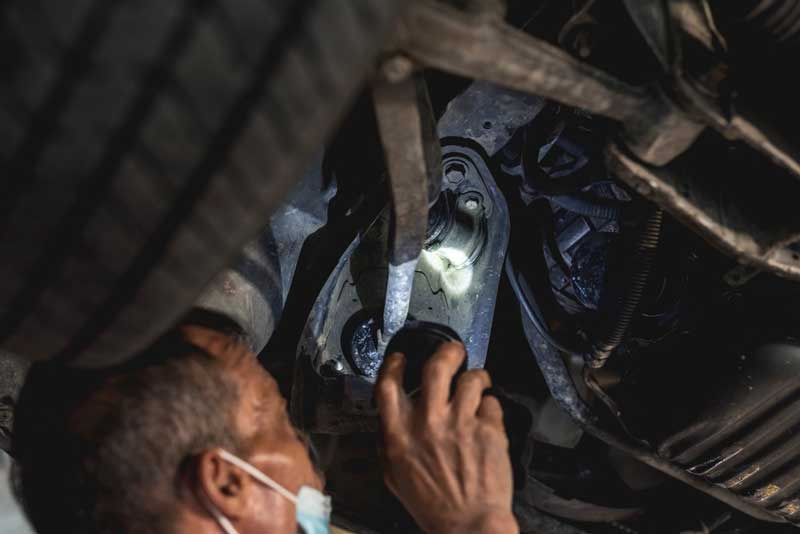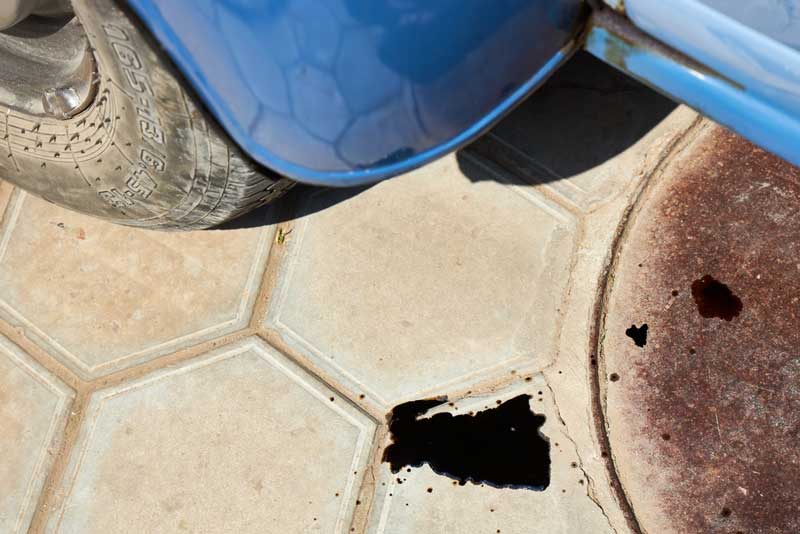Have you noticed a transmission fluid leak from your car? This can be a serious issue if not tackled right away.
There are various reasons you may be experiencing a transmission fluid leak, as a result of a cracked or rusty transmission pan or extreme heat from the transmission.
If that is the case, it’s time to fix the transmission fluid leak; fixing it doesn’t really cost so much, and most times, it is usually not difficult.
In this article, we will be discussing all related to transmission fluid leaks, the signs and symptoms of a transmission fluid leak, as well as what it will take to fix this problem.
Let’s get started!
Why Do I Experience a Transmission Fluid Leak
A transmission leak is a regular eventuality that occurs as a result of excessive wear over time. It could be the pan is punctured or the plugs are loose. Either way, when you notice transmission fluid, reach out to your local mechanic and let them inspect and fix your transmission fluid leak.
One of the general reasons transmission fluid leaks is bad transmission pan gaskets or rusty transmission pansy. If either your mechanic or you, did not properly tighten your drain plug the previous time, it might also be why it leaks. Also, it can be that the seal on your transmission is leaky.
6 Common Causes of Transmission Fluid Leak
1. Damaged Transmission Pan Gasket
The most common issue which makes automatic transmission leak is a leaky fuel pan gasket. The gasket should be changed, whenever your transmission pan is removed on most vehicle models, though most people still install the old one back. Unfortunately, this makes it leak easily. It can also be that they’re worn out and have started leaking because your transmission fluid is eating them up slowly.
Some vehicle transmission model use sealers rather than gaskets, which can get worn out and also need to be changed.
Also Read: Power Steering Pump Replacement Cost
2. When Transmission Ventilation is Clogged
To ensure that there is not much pressure inside, many automatic transmissions have a certain kind of open ventilation, at the top of your transmission. Unfortunately, some car models could congest the little transmission ventilation, thereby creating transmission leaks.
Check the top of the transmission for a ventilation hose, or ask the authorized dealer whether your transmission has ventilation or not because they’re usually installed on top of your transmission, and can be hard to reach.
3. Leakage from Transmission Pan Drain Plug
Not every automatic transmission has drain plugs, though some do, there is one on the transmission pan drain and it may be leaking. On your drain plug, there are usually O-rings that seal your drain plug, which can be changed after every fluid replacement.
Not everyone replaces their O-ring sealing when they replace their fluid, which sometimes leads to a leaky transmission.
4. When Transmission Pan is Bent
For instance, if someone changed their transmission fluid, and has an issue removing his pan due to hard sealant, the pan may get bent around the edges during removal. The steel transmission pan is usually weak, and when it is not a small screwdriver that is used to remove it, then the risk is that they could bend it. Check if there is any damage around your transmission pans edge. You might have to completely change your transmission pan if it’s bent.
5. Rusty or Cracked Transmission Pan
Another reason for a leaky transmission is if your transmission pan is cracked. Cracked transmission pans easily happen, if the transmissions have an aluminum transmission pan. For instance, hitting the aluminum transmission pan under your vehicle with a strong object, while driving.
If your transmission pan is steel, then rust is an issue. Those pans are thin materials, and they will form a hole easily when they become rusty. Check if there is rust, if you discover any, change the pan as soon as possible.
6. Opening in Transmission Fluid Pipe
Many automatic transmissions also have a cooling fluid, though not all. If you have one, you will likely have a fluid line at the vehicle’s facade, going to your transmission cooler. Unfortunately, those lines are made from steel and are likely to have rust holes, and subsequently start leaking. Also, they’re usually too close to the pan, and you often think the leak is coming from your pan, while it is from your transmission line.
Also Read: Fuel Induction Service (Everything to Know)

What are the Indications of a Transmission Leak?
1. Dipstick Level Drops
The first thing to do if you’re concerned about the transmission is to run a diagnostic check on your transmission fluid level, by looking at your dipstick, dusting it clean, re-insert it, and then removing it.
The fluid is meant to be pink and almost clear. If it looks brownish, then it has to be changed. If the level becomes low, add the needed quantity but not much. Overfilling could make your fluid hot.
2. Warning Light comes on in Dashboard
Modern vehicles have all types of dashboard warning lights. They’re designed to alert the owner, to any possible number of engine problems.
Look at the owner’s manual, to specifically see what your warning light may be saying to you. If your light remains on, it is a sign you should have your vehicle checked by a mechanic, to know the problem and possibly fix it.
3. Leakage of Fluid
The easiest way to know if the transmission is leaking is to look beneath your vehicle or on the floor of the garage or driveway.
If some spots are noticed on the floor, check your fluids’ levels to ensure everything is fine.
4. Grinding Gear Sound
If your transmission fluid becomes low, the transmission will not work smoothly. This can lead to a certain number of suspicious signs, like grinding gear. This sound may also be telling that your transmission synchronizer has been damaged. Whenever something does not sound right, check the fluid level and take the vehicle to a mechanic, to diagnose it professionally.
5. Unusual Vibration While Driving
By making strange sounds, you may also notice an odd vibration while driving. This could be that your gear is slipping.
As your fluid gets low, your transmission will not be able to function the way it was designed, thereby resulting in strange performance such as sudden surging or being extremely slow. This does not just make it vibrate and cause unreliable performance, it is also a symptom that the vehicle may be dangerous to drive.
6. Noises even when in Neutral
Not all sounds from your vehicle should make you panic or worry. But, if your vehicle starts making odd sounds, like when it changes gear or is in neutral mode, it calls for a quick check-up.
If your vehicle makes bumping sounds, it might be a good sign that the transmission fluid must be changed. The good thing about this is that it is not difficult to fix. So, it can be done without the mechanic’s help, or you can also take it to the mechanic to be done professionally, anyway.
7. Burning Smell
If the transmission fluid leaks, you might notice some kind of smell that tells you something is not right. The smell of something burning may alert you that the transmission fluids are overheating.
There’s no need to panic if this happens. It may not be related to the transmission fluid, but do not make any delay, diagnose the issue immediately. Better still, take your vehicle to a professional mechanic right away, to check and probably fix it.
8. Clacking Sounds
Another sound your vehicle may begin to make, which would inform you of your transmission problem, is a clunking sound. If the transmission starts making some clunking sounds, do not hesitate to take it to a professional mechanic to have it repaired.
9. Delay in Acceleration
The vehicle transmission is designed or made to switch or change gears immediately. Under the usual condition, your gear changes effortlessly, so you will not notice it. But when the level of your transmission gets low, there is usually a delayed response in changing from one gear to another, and the vehicle will not accelerate smoothly as it should.
As you press the gas pedals down, you will notice that the engine does not move quickly. That is a good sign that your transmission has to be checked, as soon as possible.
10. Excess Heat From the Transmission
Your vehicle’s transmission does a series of works. That is why it is very important to ensure it has enough fluid as required. If the fluid reduces or becomes low, your gear suddenly loses enough lubrication and thereby gets hot.
If the transmission is overheating, you can always notice the heat increasing on the ground, from your transfer case. Check the dashboard’s temperature gauge, for overheating symptoms on the engine.
When your transmission gets hot, you might begin to perceive a burning smell caused by the transmission fluid and will have to take it to the mechanic to fix it as soon as possible.

Basic Cost of Fixing a Transmission Fluid Leak
If your car transmission is leaking, the common cost to fix it (without removing the transmission) ranges between $150 to $200. This price will change the pan bolt, gasket, drain plugs, and fluid lines.
But the true amount depends on where the leak is on your transmission. If it is coming from the seal at the front, then you may remove your transmission first. This will lead to an increase in the cost of fixing it.
Is Driving a Car with Leaking Transmission Fluid Safe?
Though it’s not entirely dangerous to drive with leaky transmission fluid in the short term, you are advised to fix this problem immediately, to maintain your vehicle for long-term use. Once you notice your vehicle’s transmission fluid leaks, contact a qualified mechanic to service the transmission fluid. The earlier you fix it, the less issue you will encounter with your car in the long run or future.
Also Read: What is a Powertrain Warranty (Everything to Know)
Frequently Asked Questions – Transmission Fluid Leak
How serious is a transmission fluid leak?
One small fluid leak could completely damage your transmission if it is ignored. When insufficient fluid runs on the system, the parts lose lubrication, thereby causing some problems in the transmission.
How much does it cost to fix a transmission fluid leak?
The amount for fixing a transmission fluid leak in a car could be as small as $150 to change a seal, then $1,000 to get a new torque converter.
Can you drive a car leaking transmission fluid?
Though driving your vehicle when its transmission fluid is leaking is possible, it is not advisable since your car will not function as required. You have to consider safety factors. A space in the transmission system is a common cause of this leak.
How long can a car run without transmission fluid?
A vehicle without transmission fluid can run up to ten (10) miles at low speed, but this is very risky. In addition, transmission fluids are necessary for assisting your vehicle in changing gear smoothly. Without this, a gear is exposed to additional friction and might not move completely.
How long does it take to repair a transmission leak?
Fixing a transmission could take a whole day, though it can take 3-4 days at least to rebuild a transmission.

